I sometimes see this assertion. It clearly has relevance given the pattern we have as of June 2022 data. The red arrows indicate local maxima.
Figure 1: Civilian employment over age 16 (blue, left log scale), nonfarm payroll employment (tan, right log scale), both in 1000’s, seasonally adjusted, both as of 7/24/2022. Source: BLS via FRED.
The argument is based on the conjecture that the BLS birth/death model (see discussion here) used to process data from the establishment survey is most likely to go off track at turning points, and in particular, during the Great Recession and the covid pandemic.
Looking at the last four recessions, we see the following patterns:
Figure 2: Civilian employment over age 16 (blue, left log scale), nonfarm payroll employment (tan, right log scale), both in 1000’s, seasonally adjusted, both as of 7/24/2022. NBER defined peak-to-trough recession dates shaded gray. Source: BLS via FRED, NBER.
Figure 3: Civilian employment over age 16 (blue, left log scale), nonfarm payroll employment (tan, right log scale), both in 1000’s, seasonally adjusted, both as of 7/24/2022. NBER defined peak-to-trough recession dates shaded gray. Source: BLS via FRED, NBER.
Figure 4: Civilian employment over age 16 (blue, left log scale), nonfarm payroll employment (tan, right log scale), both in 1000’s, seasonally adjusted, both as of 7/24/2022. NBER defined peak-to-trough recession dates shaded gray. Source: BLS via FRED, NBER.
Figure 5: Civilian employment over age 16 (blue, left log scale), nonfarm payroll employment (tan, right log scale), both in 1000’s, seasonally adjusted, both as of 7/24/2022. NBER defined peak-to-trough recession dates shaded gray. Source: BLS via FRED, NBER.
In two cases, the civilian employment series (household survey) peaks before the nonfarm payroll series (establishment survey), that is the 1990 and 2007 recessions; in the former, case the household peak is a whole three months earlier. In one case, the establishment series peaks first, and another, they are tied (2020).
Now, these are the final revised series, as of 7/24. They are not what economists would’ve seen as they were contemplating the possibility of a downturn. What did the series look in “real time”, i.e., as observers were contemporaneously assessing the onset of a recession? The corresponding figures are shown in Figures 6-9.
Figure 6: Civilian employment over age 16 (blue, left log scale), nonfarm payroll employment (tan, right log scale), both in 1000’s, seasonally adjusted, both as of 6/7/1990. NBER defined peak-to-trough recession dates shaded gray. Source: BLS via ALFRED, NBER.
Figure 7: Civilian employment over age 16 (blue, left log scale), nonfarm payroll employment (tan, right log scale), both in 1000’s, seasonally adjusted, both as of 5/4/2001. NBER defined peak-to-trough recession dates shaded gray. Source: BLS via ALFRED, NBER.
Figure 8: Civilian employment over age 16 (blue, left log scale), nonfarm payroll employment (tan, right log scale), both in 1000’s, seasonally adjusted, both as of 2/1/2008. NBER defined peak-to-trough recession dates shaded gray. Source: BLS via ALFRED, NBER.
Figure 9: Civilian employment over age 16 (blue, left log scale), nonfarm payroll employment (tan, right log scale), both in 1000’s, seasonally adjusted, both as of 4/3/2020. NBER defined peak-to-trough recession dates shaded gray. Source: BLS via ALFRED, NBER.
In real time, the household series turns one month earlier than the establishment in two cases (2001, 2007), and twice the turning points are the same time (1990 and 2020). In the revisions, the civilian series peaks are moved earlier once (1990), and later by two months (2001). The NFP peak is moved later once (2001 recession).
I do not think one should take too much from the current flattening out of the household series. With this in mind, here’s a recap of the two series, plus the household series adjusted to a NFP concept. This latter series was developed in response to conservative criticism that the conventional establishment series, relying on the birth/death model, was prone to error in the wake of the 2001 recession (i.e., critics argued employment was underestimated). The research series is shown in red below, and is not subject to the same problems with estimating the birth and deaths of firms (but does suffer from the same relatively small sample size associated with the household survey).
Figure 10: Civilian employment over age 16 (blue), civilian employment adjusted to nonfarm payroll concept (BLS series LNS16000000) (red), nonfarm payroll employment (tan), Bloomberg consensus of 7/25 (tan square), all in 1000’s on log scale, seasonally adjusted, all as of 7/24/2022. Source: BLS via FRED, BLS, Bloomberg, and author’s calculations.
The June civilian employment was down, while civilian employment adjusted to NFP concept was up (-315, + 131), while NFP was up 372. The Bloomberg consensus for July as of today is +255.
Addendum: Using the final revised series, we have household series peaks in the middle of recessions, at 1960M09, 1970M04, 1974M07, and 1980M02.


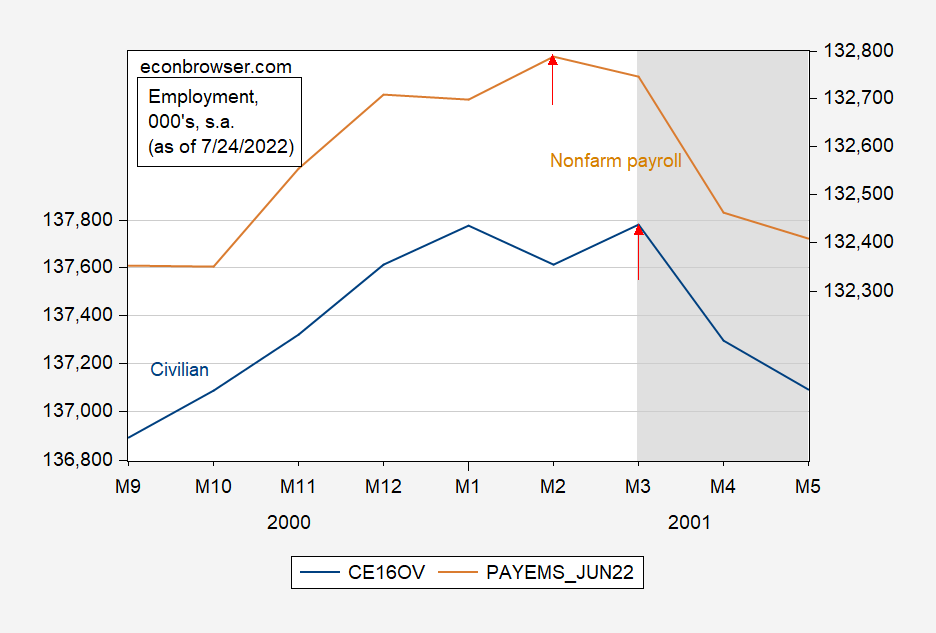

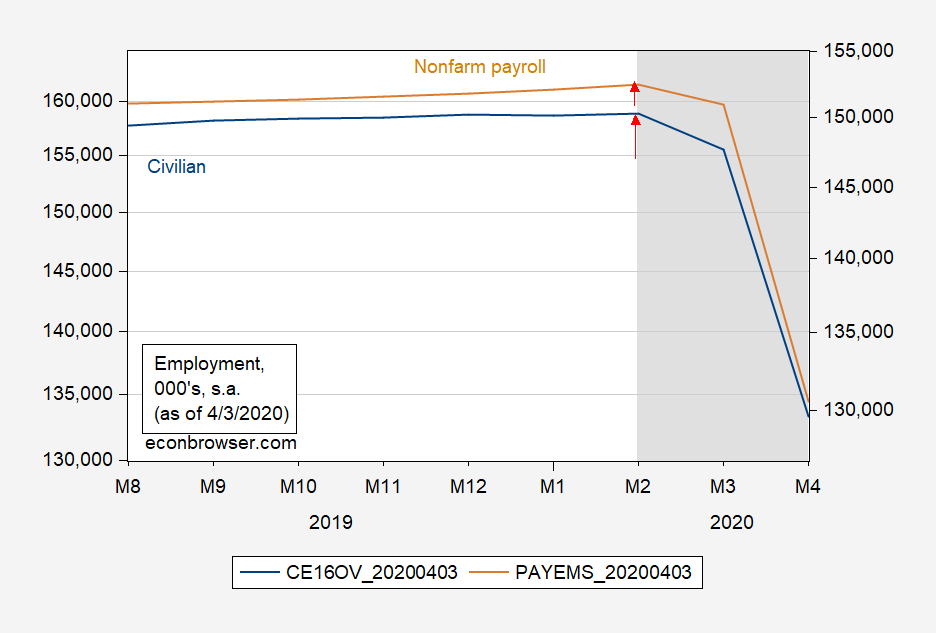
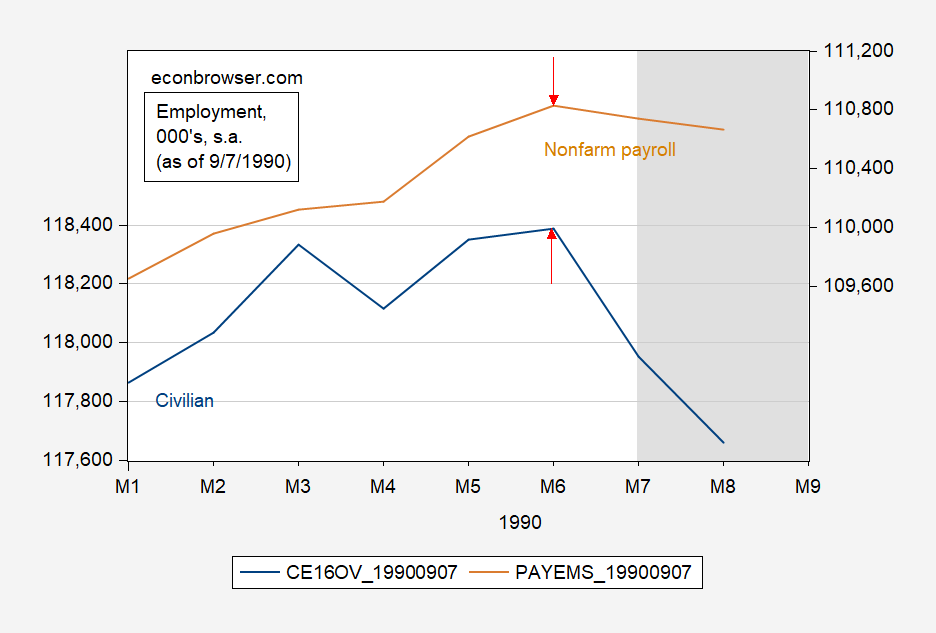
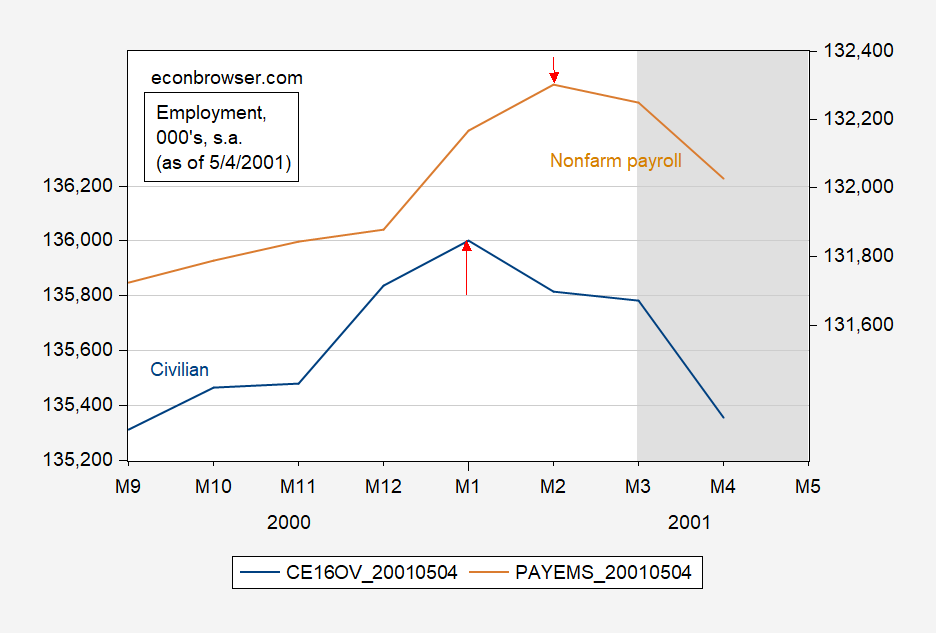
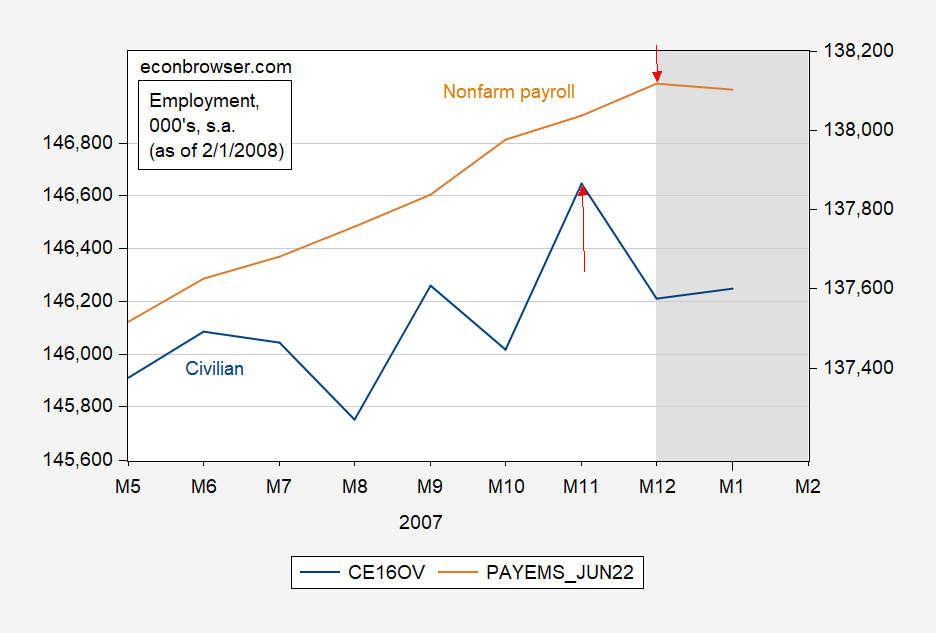
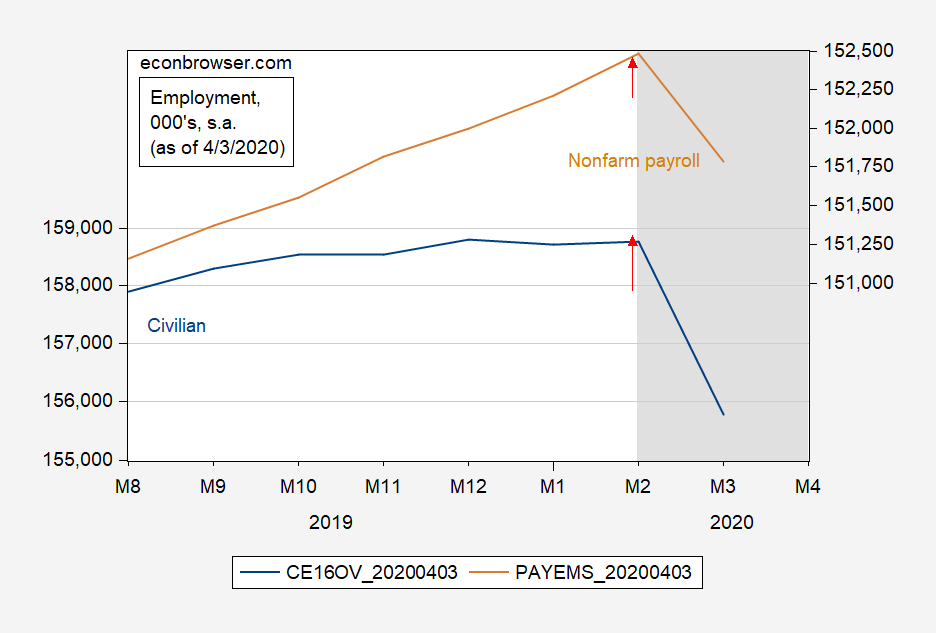
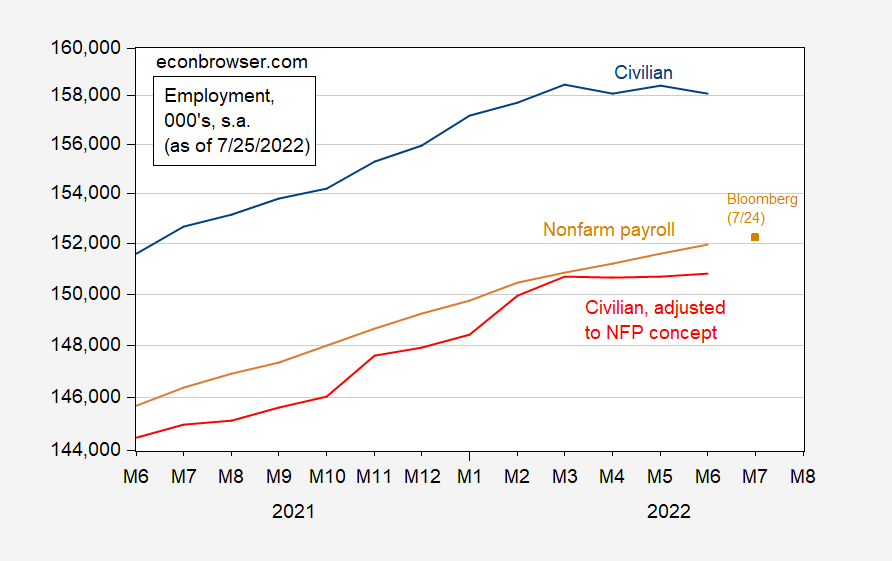
Chinese consumer sentiment just went down the hopper. Meanwhile, the IMF April WEO suggests China’s population begins to decline this year. Mix that in with perhaps the world’s biggest housing bubble, and I think China’s looking at a hard landing.
RECESSION HERE! RECESSION THERE! Oh my Princeton Chicken Little says the world is coming to an end!
PMIs look terrible across the globe. Yes, I think there is a hard landing coming fast.
But percentages don’t do a good job at painting the whole picture so here are the raw numbers:
2 years ago:
Average new car: 38k
Average used car: 20k
So what about 2022?
Average new car: 50k (+24%)
Average used car: 31k (+35%)
Oh, this ends ugly.
https://twitter.com/SullyOmarr/status/1550255817001037824
WTF does this have to employment growth? Seriously dude – you need to start taking meds.
BTW – who gives a damn what is on the Twitter of someone named Sully Omarr. Forget the meds – you need serious professional help.
Market pressures. Go figure.
Anyone who remotely understands the data reported by BLS knows that the Household Survey is a very noisy series. So why would any rational person be running around screaming RECESSION because this survey turned negative for a month?
Its noisy but can lead the pack. The current “decline” is not uncommon inside of a expansion. The mid-80’s decline taking note.
A related issues is whether the civilian survey produces false positives, declining without a recession following soon after. Yes, false positives are common:
https://fred.stlouisfed.org/graph/?g=S9mX
From April, 2010, when the payroll series began a nearly uninterrupted rise until the end of 2019, the civilian survey produced declines over twenty times. In 2011 and 2013, there were strings of declines in the civilian job tally.
Another fact evident from the chart, and known to anyone who pays attention to the data, is that the civilian series is more volitile than the payroll series. That voliatility goes hand in hand with frequent declines in an upward-trending series.
Hiring appears to be slowing, and there is good reason to expect it will slow. Till now, though, the average monthly pace of job gain is considerably faster than the 75,000-125,000 pace of gain normally needed to absorb new entrants to the labor market.
China is its own thing and is going to have its own problems. I’m less concerned about China than Europe, which is in for a rough time.
One thing to think about when looking at these numbers is the unemployment rate. If overall employment is flat, but the unemployment rate is around 3%, I’m not sure how anybody could argue that lack of growth in employment is not due, at least in part, to labor supply issues. It may very well not be an indicator of a downturn. It may indicate that we need immigrants.
Yes, but in a purely causal, math sense, a recession can become much more likely when hiring has slowed due to a tight labor market. Growth slows because of a lack of new inputs. Slow growth means contraction is easier.
What we keep hearing from the comment goons is that somebody (Biden and Democrats, mostly) should be blamed for what is outside their control. We aren’t in recession, but if we were, it wouldn’t be because of bad policy. There has been a series of big shocks. Policy has dealt with those risks, but can’t make them go away.
MD is convinced: “What we keep hearing from the comment goons is that somebody (Biden and Democrats, mostly) should be blamed for what is outside their control. We aren’t in recession, but if we were, it wouldn’t be because of bad policy. There has been a series of big shocks. Policy has dealt with those risks, but can’t make them go away.”
Read at least one of the books on the subject and then rethink that conclusion. Most make a compelling case for Presidential policies driving economics. You might also graph this current INFLATION curve, and not just energy.
CoRev: Please, give me the title of one book published by a reputable publisher that states that presidents’ policies are responsible for recessions and inflationary episodes.
I will go check if Dr. Seuss ever wrote something like that. After all books for little children is something CoRev considered advanced reading.
Presimetrics. There are others. Now you want us to believe you are expert on publishers reputability?
CoRev
July 26, 2022 at 8:24 am
Presimetrics.
CoRev could have provided the Amazon review but let me step up and do it for him:
https://www.amazon.com/Presimetrics-Facts-Presidents-Measure-Issues-ebook/dp/B0041IXRWA
Presimetrics: What the Facts Tell Us About How the Presidents Measure Up On the Issues We Care About Kindle Edition
by Mike Kimel (Author), Nigel Holmes (Author, Illustrator)
Editorial Reviews
About the Author
Mike Kimel is an economic consultant who has built sophisticated statistical tools used by the military, NASA, and other government agencies. He also taught economics and advanced statistics at Pepperdine University, ran the internal consulting group for a Fortune 500 telecom company, and worked for a Big 4 accounting firm. He holds a Ph.D in economics from UCLA. He lives in Akron, Ohio, where he works at a diversified regional energy company. He is a contributing blogger on angrybear.com, one of the top economic blogs in the country.
Michael E. Kanell is an economics writer for the Atlanta Journal-Constitution. He has appeared on television and radio, including CNBC, NPR, and various local stations across the country. He has a bachelor’s degree in history from Princeton University and a law degree from Boston University, where he was also adjunct professor of the College of Communications. He lives in Atlanta, Georgia.
Nigel Holmes is an award-winning information graphics specialist. His work has appeared in countless publications, including Time (where he worked as graphics director), Adweek, GQ, Details, Discover, Money, Rolling Stone, Sports Illustrated, The New York Times, and more. He lives in Westport, Connecticut.
Pepperdine? The AJC? Adweek? No wonder Amazon slashed the price of this book to $4.75,
Barking Bierka – the Disgusting NYC Jerk, was this one of the periods when you had banned from writing and commenting at AB for the same behavior you show here daily?
Just asking for a friend.
CoRev,
I have not read this book, indeed had not heard of it before. But, Ihope you are aware that over the post-WW II era, economic perfornance as measurred by growth or almost anything has been substantially better under Dem presidents than GOP presidents? Even the case that supposedly gave GOP an edge, Reagan doing better than Carter, is not all that dramatic and more a matter of timing when things did well versus badly in their presidencies.
This looks like a complete fail to me.
As it is, even though the Dem preses have done better than the GOP ones, I tend to share the more general view of most economists that they actually have relatively lilttle input into overall economic performance during their presidenies, although not zero.
BTW, as somebody who does currently comment on Angry Bear, I do not now why pgl has not done so lately (which he used to do by posting on Econospeak from where AB picked his stuff up), but I can assure your “friend” that has nothing to do with him being banned for bad behavior or anything of the sort.
Barkley, I assure our NYC Jerk was banned from contributing articles and comments on AB. Maybe more than once. There are many who no longer comment or are allowed to comment at AB. That includes the author of Presimetrics.
This book and Trump’s and Biden’s administrations refute this: “I tend to share the more general view of most economists that they actually have relatively lilttle input into overall economic performance during their presidenies, although not zero.” Since WWII it’s hard to ignore the economic policy impacts of Johnson, Nixon, Carter, Reagan, Trump and Biden.
https://www.msn.com/en-us/money/markets/the-fed-will-eventually-choose-propping-up-growth-over-fighting-inflation-and-will-start-cutting-rates-next-year-says-blackrock/ar-AAZWFoo?ocid=msedgdhp&pc=U531&cvid=99565b3ec3144c64854b66b4434d12ed
Blackrock is telling its clients that the FED will start lowering interest rates by early next year.
10 physicist looked at the data and came to the same conclusion; 10 economists looked at the data and there was no agreement.
https://finance.yahoo.com/news/shallow-recession-calls-totally-delusional-153908219.html
https://www.pnas.org/doi/10.1073/pnas.2120557119
April 19, 2022
Self-adaptive integration of photothermal and radiative cooling for continuous energy harvesting from the sun and outer space
By Xianze Ao, Bowen Li, Bin Zhao, Mingke Hu, Hui Ren, Honglun Yang, Jie Liu, Jingyu Cao, Junsheng Feng, Yuanjun Yang, Zeming Qi, Liangbin Li, Chongwen Zou and Gang Pei
Significance
The sun (∼6,000 K) and outer space (∼3 K) are two natural energy resources for humans. However, most of the approaches of energy harvesting from the sun and rejecting energy to outer space are achieved independently using absorbers and emitters with static spectral properties. Herein, a spectrally self-adaptive structure with strong solar absorption and switchable emissivity within the atmospheric window (i.e., 8 to 13 μm) is experimentally demonstrated to achieve diurnal solar thermal and nocturnal radiative cooling efficiently. The experiment shows that the proposed structure not only can be heated to 185°C in diurnal mode but also be cooled to −12°C in nocturnal mode. This work opens new possibilities for continuously efficient energy harvesting utilizing the sun and the universe.
Beyond theory, China has already developed and is now using a metallic “photothermal and radiative cooling” coating on the laboratory component of the international space station. The working life of the Chinese space station should be extended from 10 to 15-20 years. Also, the metallic coating is being applied when applicable to readying satellites:
https://english.news.cn/20220525/8f57a03ce7c7474b803a53cbe88d98a2/c.html
May 25, 2022
Scientists engineer new material that can harvest energy 24-hr uninterrupted
HEFEI — A new type of material has been developed that can absorb heat from the sun during the day and emit energy to outer space to harvest cooling at night, according to a recently published article. *
The base of the coating material is vanadium dioxide (VO2) film and its switch from heating to cooling mode throughout a 24-hour day-night cycle creates no extra energy costs, according to Pei Gang and Zou Chongwen, leading scientists of the study from the University of Science and Technology of China.
With self-adaptability properties, the VO2 film is in a metallic phase and can be heated to 170 degrees Celsius above ambient temperature under sunshine, while in darkness, the VO2 film transforms into an insulator and can be cooled to 20 degrees Celsius below ambient temperature.
The study represents a novel approach for harvesting renewable energy from sunlight and outer space and is of emerging interest, according to its peer-review.
The breakthrough of the study is to harvest ‘heat and cool’ in a single structure, which saves space and reduces costs, said Pei.
The material could be applied to fields including energy conservation in buildings, cooling photovoltaic systems, thermoelectrics and energy supply in outer space, according to Pei….
* https://www.pnas.org/doi/10.1073/pnas.2120557119
https://news.cgtn.com/news/2022-05-26/China-makes-progress-harvesting-energy-from-sun-outer-space-cooling-1alkUkEM5Xy/index.html
May 26, 2022
Chinese scientists make breakthrough harvesting energy from sun, outer space cooling
Chinese researchers have developed a new type of material to absorb heat from the sun during the day and emit energy to outer space to harvest cooling at night in a novel approach for harvesting renewable energy, Xinhua news agency reported.
The results of their study * were published online in the Proceedings of the National Academy of Sciences (PNAS). The breakthrough finding is in harvesting “heat and cool” in a single structure, saving space and reducing costs, according to Pei Gang and Zou Chongwen, leading scientists from the University of Science and Technology of China.
The base of the coating material is vanadium dioxide (VO2) film and its switch from heating to cooling mode throughout a 24-hour day-night cycle creates no extra energy costs, said the Chinese scientists.
With self-adaptability properties, the VO2 film is in a metallic phase and can be heated to 170 degrees Celsius above ambient temperature under sunshine, while in darkness, the VO2 film transforms into an insulator and can be cooled to 20 degrees Celsius below ambient temperature….
* https://www.pnas.org/doi/10.1073/pnas.2120557119
[ This means safer and more comfortable spaceships. ]
https://news.cgtn.com/news/2022-07-25/Shenzhou-14-crew-enter-Wentian-lab-module-1bWR4zNYvOo/index.html
July 25, 2022
Space log: Shenzhou-14 taikonauts enter Wentian lab module
By Sun Ye
The Shenzhou-14 crew entered the Wentian lab module at 10:03 a.m. Beijing Time (BJT) on Monday, the China Manned Space Agency (CMS) announced, marking the first time that Chinese astronauts, or taikonauts, have entered a lab module in orbit.
According to the plan, China will carry out in-orbit works, such as integrated attitude control of the space station and tests on Wentian’s small robotic arm as well as the larger robotic arm on the core module.
Launched on Sunday afternoon, Wentian docked with the front port of the Tianhe core module of China’s space station at 3:13 a.m. BJT on Monday after it entered the planned orbit and completed state setting.
It is the first time that China’s two 20-tonne-level spacecraft conducted rendezvous and docking in orbit, and also the first time that space rendezvous and docking were carried out during the astronauts’ in-orbit stay in the space station, the CMS said.
A dedicated airlock cabin for EVAs
For the first time, the taikonauts in orbit can use the airlock cabin in Wentian to carry out extravehicular activities (EVAs). The node cabin in the core module, which usually serves as the exit and entry for EVAs, will become a backup of the airlock cabin.
Compared with the node cabin, the airlock cabin has a larger door, which is more convenient for the taikonauts to enter and exit the spacecraft as well as transfer tools and maintenance equipment.
The Shenzhou-14 crew will, for the first time, be aided by the small mechanical arm to carry out EVAs. The taikonauts are also scheduled to give another space lecture from the Wentian lab module.
A reliable, spacious, multitasking module …
Thanks Chinny for this. Downunder we only have the household series.
They are both lagging indicators so they won’t tell you if the country is in recession
https://fred.stlouisfed.org/graph/?g=RqcN
August 4, 2014
Real per capita Gross Domestic Product for China, United States, India, Japan and Germany, 1977-2021
(Percent change)
https://fred.stlouisfed.org/graph/?g=RqcV
August 4, 2014
Real per capita Gross Domestic Product for China, United States, India, Japan and Germany, 1977-2021
(Indexed to 1977)